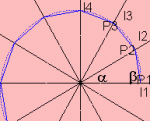I am an amateur guitar builder. I am trying to solve a problem for a hobby project but my math skills are not up to the task:
To calculate the locations for a number (N) of frets along a guitar string of length (L) we start at the nut and divide the remaining length of string by 17.817 (a number related to the 12th root of 2 = 1.059463094359). The frets get successively closer together as we move closer to the bridge.
The problem is how do you construct a spiral such that as that spiral is rolled along the string from the nut to the bridge it contacts a fret at every R degrees of rotation? R is a constant angle. My N=32, L=30", and R=36degrees but I would prefer a more general solution.
At first I thought that I could simply make concentric circles where each fret spacing subtends R degrees of each circle's circumference, then simply mark the edge of each segment and connect the dots. Unfortunately, this will not work because the axis changes height continually as it is rolled. It might be a logarithmic spiral of some sort. Although the logarithmic spiral formula on wikipedia baffles me (what is a & b?) I did find some more understandable java code that plots a log spiral. That doesnt really help me to solve this problem though. If I could understand the solution I might be able to edit the code to provide a general solution. I am a java engineer. Any clue?
Thanks,
Clark
To calculate the locations for a number (N) of frets along a guitar string of length (L) we start at the nut and divide the remaining length of string by 17.817 (a number related to the 12th root of 2 = 1.059463094359). The frets get successively closer together as we move closer to the bridge.
The problem is how do you construct a spiral such that as that spiral is rolled along the string from the nut to the bridge it contacts a fret at every R degrees of rotation? R is a constant angle. My N=32, L=30", and R=36degrees but I would prefer a more general solution.
At first I thought that I could simply make concentric circles where each fret spacing subtends R degrees of each circle's circumference, then simply mark the edge of each segment and connect the dots. Unfortunately, this will not work because the axis changes height continually as it is rolled. It might be a logarithmic spiral of some sort. Although the logarithmic spiral formula on wikipedia baffles me (what is a & b?) I did find some more understandable java code that plots a log spiral. That doesnt really help me to solve this problem though. If I could understand the solution I might be able to edit the code to provide a general solution. I am a java engineer. Any clue?
Thanks,
Clark

